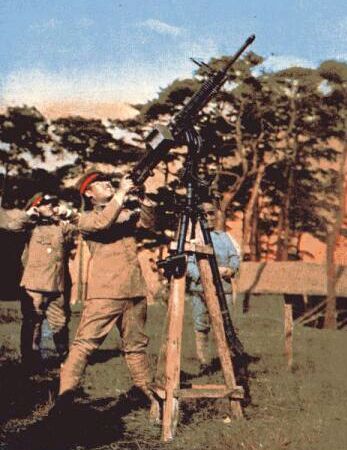Type 3 Heavy Machine Gun on:
[Wikipedia]
[Google]
[Amazon]
, also known as the Taishō 14 machine gun, was a Japanese air-cooled
 It used an ammo strip for loading rounds. Its tripod could be used as an anti-aircraft mounting, and special anti-aircraft sights were provided.
It used an ammo strip for loading rounds. Its tripod could be used as an anti-aircraft mounting, and special anti-aircraft sights were provided.
Japanese Type 92 Heavy Machine Gun (9885155276).jpg, A Type 3 and Type 92 next to each other at a Beijing museum, showing the similarity
Chilean Type 3 (M1920) machine gun.jpg, A 7-mm export gun in a Chilean museum
Chilean contract Type 3 (M1920) machine gun.jpg, Ditto
Military exercise of Manchukuo Imperial Army.JPG, In service with the
Japanese machineguns of WW2
Heavy machine guns Machine guns of Japan World War I machine guns World War I Japanese infantry weapons World War II infantry weapons of Japan World War II machine guns Machine guns of Manchukuo Weapons and ammunition introduced in 1914 {{machinegun-stub
heavy machine gun
A heavy machine gun (HMG) is significantly larger than light machine gun, light, medium machine gun, medium or general-purpose machine guns. HMGs are typically too heavy to be man-portable (carried by one person) and require weapon mount, mountin ...
.
Design
The Type 3 heavy machine gun was based on the design of theHotchkiss M1914
The Mle 1914 Hotchkiss machine gun chambered for the 8mm Lebel cartridge became the standard machine gun of the French Army during the latter half of World War I. It was manufactured by the French arms company Hotchkiss et Cie, which had been es ...
. Although the Hotchkiss used 8mm cartridges, from 1914 Japan produced the Type 3 under license from Hotchkiss using the 6.5x50mm Arisaka ammunition.
 It used an ammo strip for loading rounds. Its tripod could be used as an anti-aircraft mounting, and special anti-aircraft sights were provided.
It used an ammo strip for loading rounds. Its tripod could be used as an anti-aircraft mounting, and special anti-aircraft sights were provided.
Users
* : Chile bought several hundred Type 3 machine guns in7×57mm Mauser
The 7×57mm Mauser (designated as the 7 mm Mauser or 7×57mm by the SAAMI and 7 × 57 by the C.I.P.) is a first-generation smokeless powder rimless bottlenecked rifle cartridge. It was developed by Paul Mauser of the Mauser company in ...
as ''Modelo 1920''. Barrels were manufactured in France by Hotchkiss but most of the weapon was made at the Kokura
is an ancient castle town and the center of Kitakyushu, Japan, guarding the Straits of Shimonoseki between Honshu and Kyushu with its suburb Moji. Kokura is also the name of the penultimate station on the southbound San'yō Shinkansen lin ...
arsenal.
* : Purchased for Chang Tso-lin's Fengtian Army. Later used by the Collaborationist Chinese Army
The term Collaborationist Chinese Army refers to the military forces of the puppet governments founded by Imperial Japan in mainland China during the Second Sino-Japanese War and World War II. They include the armies of the Provisional (1937–194 ...
*
*
* : It was used by the Korean People's Army
The Korean People's Army (KPA; ) is the military force of North Korea and the armed wing of the Workers' Party of Korea (WPK). Under the ''Songun'' policy, it is the central institution of North Korean society. Currently, WPK General Sec ...
during the Korean War
, date = {{Ubl, 25 June 1950 – 27 July 1953 (''de facto'')({{Age in years, months, weeks and days, month1=6, day1=25, year1=1950, month2=7, day2=27, year2=1953), 25 June 1950 – present (''de jure'')({{Age in years, months, weeks a ...
.
*
Gallery
Manchukuo Imperial Army
The Manchukuo Imperial Army ( zh, s=滿洲國軍, p=Mǎnzhōuguó jūn) was the ground force of the military of the Empire of Manchukuo, a puppet state established by Imperial Japan in Manchuria, a region of northeastern China. The force was prim ...
See also
*Type 92 heavy machine gun
was a Japanese heavy machine gun, related to the Hotchkiss machine gun series. It entered service in 1932 and was the standard Japanese heavy machine gun used during World War II. Known for its reliability, it was used after the war by various fo ...
*Type 1 heavy machine gun
was a heavy machine gun used by the Imperial Japanese Army during the later stages of the Second World War. Though seemingly intended to replace the older Type 92 heavy machine gun, the weapon never underwent the same level of mass production a ...
Notes
Bibliography
*External links
Japanese machineguns of WW2
Heavy machine guns Machine guns of Japan World War I machine guns World War I Japanese infantry weapons World War II infantry weapons of Japan World War II machine guns Machine guns of Manchukuo Weapons and ammunition introduced in 1914 {{machinegun-stub